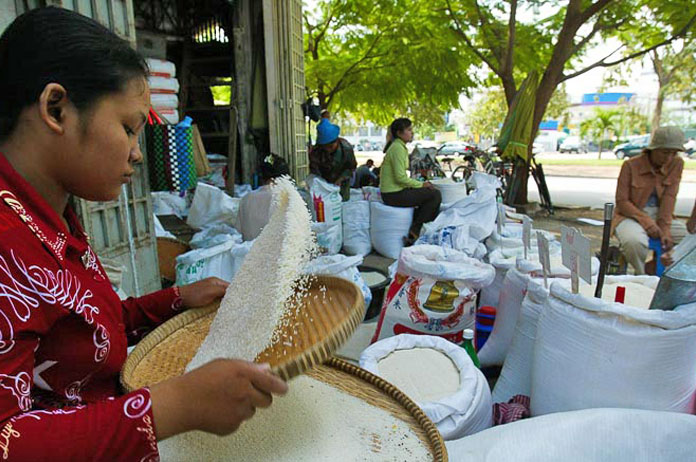Government To Intervene In Rice Sector
The government, with a budget of $50 million for emergency loans and $30 million for building silos and warehouses, will intervene to stabilise rice prices during the up-coming harvest season to ensure that the livelihoods of farmers, millers and exporters are protected.
 An oversupply of rice is expected this year due to better climate conditions for farming. KHMER TIMES / CHOR SOKUNTHEA
An oversupply of rice is expected this year due to better climate conditions for farming. KHMER TIMES / CHOR SOKUNTHEA
Vongsey Vissoth, secretary of state for the Ministry of Economy and Finance, said at a workshop yesterday that government intervention was needed because an oversupply of rice was expected due to better climate and there was a lack of silos and warehouses in the country to store the surplus.
“Our intervention is to build silos and warehouses and we would also give out loans to purchase rice from farmers,” said Vissoth. “All provincial governors have to facilitate between rice millers and their intermediaries to prevent the price of rice from falling due to an oversupply.”
Vissoth noted that for the 2017-2018 rice harvest season, government had allocated $50 million for emergency loans to rice millers and another $30 million to build silos and warehouses in Battambang, Kampong Thom, Prey Veng and Takeo provinces.
He added that he also wanted all local authorities and all provincial governors to help transport the harvested rice from the fields to warehouses, if roads could not be built on time. “All border officials, local authorities and Camcontrol officers must facilitate the export of rice to neighbouring countries and also help stem out rice smuggling through illegal border crossings,” said Vissoth.
Norng Veasna, vice president of Cambodia Rice Federation (CRF), welcomed the government’s move. He said that private sector also needed to join hands with the government to help stabilise rice prices and boost exports.
“We call on all CRF members to purchase rice from farmers and also contact the Rural Development Bank to apply for loans, in case they lack working capital to purchase paddy rice from farmers,” said Veasna. “We don’t want the price of our premium fragrant rice to fall below 900 riel ($0.23) per kilo,” he added.
Vissoth pointed out that from 2010 till 2016, rice production was on the average of about 3 million tonnes a year. However, he said, rice production this year is expected to be more than 10 million tonnes due to better weather.
“Our rice is cheap compared to neighbouring countries but when it arrives in the rice mills for processing and later transported to the port for export, all kinds of costs are added. At the end of the day, the price is higher than neighbouring countries,” said Vissoth. “So our issue is on the post-harvest scenario. Clearly, it is a market failure in the rice sector.”
Hun Lak, CRF’s vice-president, told Khmer Times recently that the current crisis in Cambodia’s rice sector was caused by domestic and external market factors. Lak pointed out that high electricity rates were eating significantly into the production costs of rice millers.
“We are trying to find ways to lower the cost of electricity. We want the electricity rate to be reduced to less than 400.60 riel (10 cents) per kilowatt hour for the agricultural sector,” he said. Residents in rural areas pay higher electricity rates than those living in town, who pay 20 cents per kilowatt hour. In comparison, farmers in Vietnam pay about 10 cents per kilowatt hour.
Lak said Cambodia needed to learn from its neighbours on how to lower rice production costs, despite falling exports. “When we look at Vietnam and Thailand, we see that they have lower production costs than us. They can lower the price of their rice, when global prices are depressed, and still survive. We, however, seem to have a problem with that,” he said.
This article was originally published in the Khmer Times. [democracy id="25"]